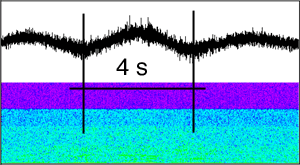

The Picture above shows the measuring system used. Typically VLF signal
is recorded simultaneously on the second channel.
Unfortunately, this night (27.-28.3.2001) the VLF was not ON.
B&K 4179 has its own high guality, low noise preamplifier with
low output impedance.
After some 30 nights outdoor recordings there is no single case where
the VLF or any radio interference could be found on the audio tract.
The robustness of the system will be tested in the Laboratory of
Radio Engineering at HUT before the final conclusions.

The spectral components below 2 kHz contain infrasound and barking of the dogs. The higher harmonics of the instrumental sound are seen below the 4 kHz peak. For some reason (?!) the lowest harmonics of the instrumental sound are located close to the 9091 Hz "carrier".
The carrier at 9091 Hz was modulated down and another radio station with male speech was descovered in combination with the lowest harmonics of the instrumental sound! This signal is given as the right channel signal in the audio example 2.
The carrier at 9 kHz fluctuates in frequency and in amplitude during one hour of recording around the instance of the radio effect. During the effect the carrier has its highest amplitude value of more than 30 dB over the average noise level. Its frequency gradually increases during the analyzed hour.
The down modulated signal shows slow, almost sinusoidal variation in the carriage frequency. The length of one cycle in this frequency variation is about 4 seconds.

The picture above shows the down modulated waveform and its spectrogram with some harmonic structures.